by Jason Bodner
January 3, 2024
Happy New Year! The party is just getting started, but beware! Champagne corks can pop out at 25 miles per hour, so watch your eyes, as Americans guzzle over 360 million glasses of bubbly each New Year’s.
Remember how we gladly toasted the new decade four years ago, but that now seems like a distant eerie nightmare, since COVID-19’s wicked arrival in America came just about two months into the new year. The unthinkable happened, and Planet Earth essentially shut down, as nearly everyone stayed home.
Once the realization came that life could continue, we resumed as much of a normal life as we could manage. Most of our “lives” took place online, as we worked, shopped, ordered food or socialized online. Stocks initially swooned, but the advent of a super-accommodative central bank policy and the realization that we could adapt, and even eventually thrive, gave investors some new optimism, and stocks soared.
For me, March of 2020 simultaneously feels like a very long time ago and only yesterday. Interestingly, looking at the stock data from the COVID-19 era and the last two months makes for an uncanny mirror image. This is important, because many investors are dubious of the latest amazing rally. I have made no secret about being bullish for the next year and beyond. But as always, I live in a world of objectivity and cold, hard data. So, let’s do some side-by-side comparisons between COVID and recent market trends.
Let’s start, as we usually do, with the Big Money Index (BMI) and the distribution of buying from when each rally began. First up, we have the 12 months from June 2019 through June 2020. The chart on the left is the BMI. You may recall that I talked about how in January, the market (blue area in the left chart) rose while the BMI started falling. This was the first indication that smart money was selling ahead of some major globe-changing news. Stocks continued to rise well into February while the BMI showed smart money continued to sell. It descended far in advance of stocks until it hit oversold, signaling a big reversion was near. This kicked off a nearly two-year rally of 115% in SPY, the S&P 500 tracking ETF.
The chart on the right shows what kinds of stocks led the start of the rally through the next four months. Notice how the largest rivers of money flowed into small- and mid-cap stocks.
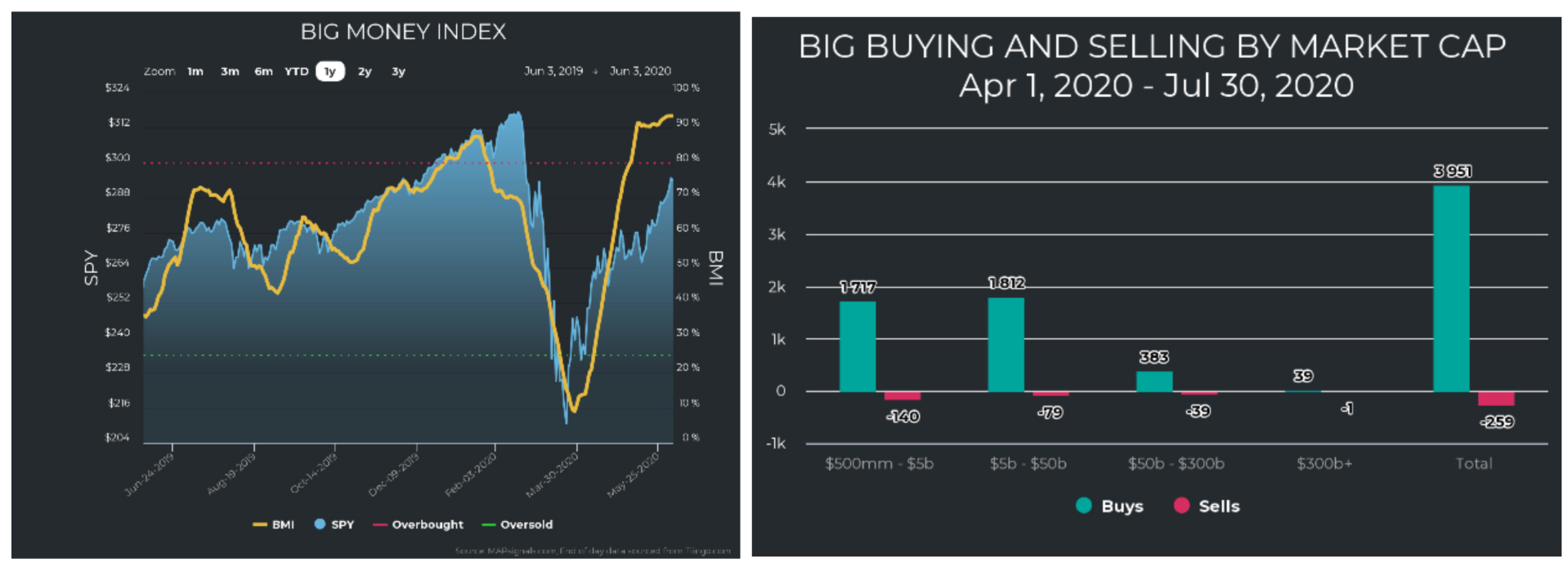
Graphs are for illustrative and discussion purposes only. Please read important disclosures at the end of this commentary.
Now let’s compare those charts to the last two-month rally. The BMI again is on the left. We see a similar pattern of overbought falling while the market remained resilient until it ultimately cracked:
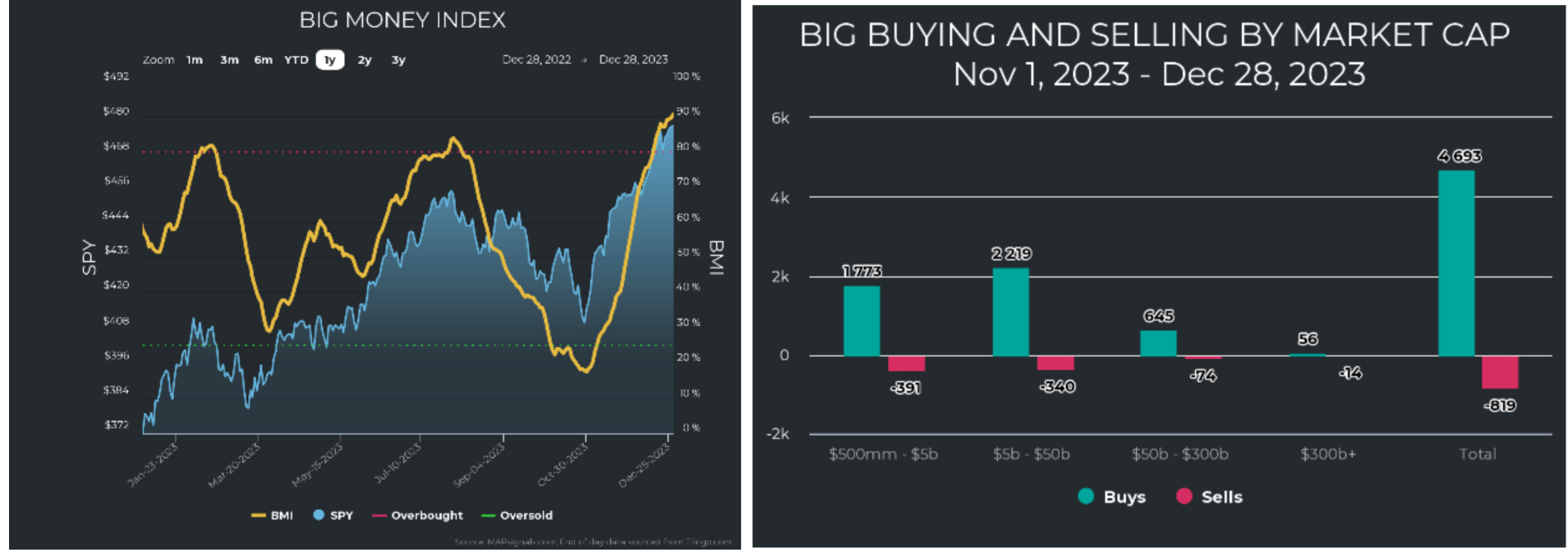
Graphs are for illustrative and discussion purposes only. Please read important disclosures at the end of this commentary.
The BMI hit oversold, prefacing a big reversion. The bounce came right on time and, as of this writing, we witnessed a 16.6% rally in the SPY. Remarkable as this rally may seem, when we look at the distribution of buying, once again we see immense inflows into small and midcap stocks, only this time, we see more buying than in the four-month post-COVID market, in only half the time!
Let’s compare the unusual buying and selling of stocks over the two timeframes. First, we notice that the initial selling “into fear” was off-the-charts as COVID’s reality hit. The subsequent buying was just as huge, and more intense than prior to COVID, when the world was blissfully unaware of the pandemic.
Comparing then to now, we see that same pattern of huge intense buying into the rally. That means stocks are not only going up, they are going up on unusually large volume, indicating institutional accumulation:
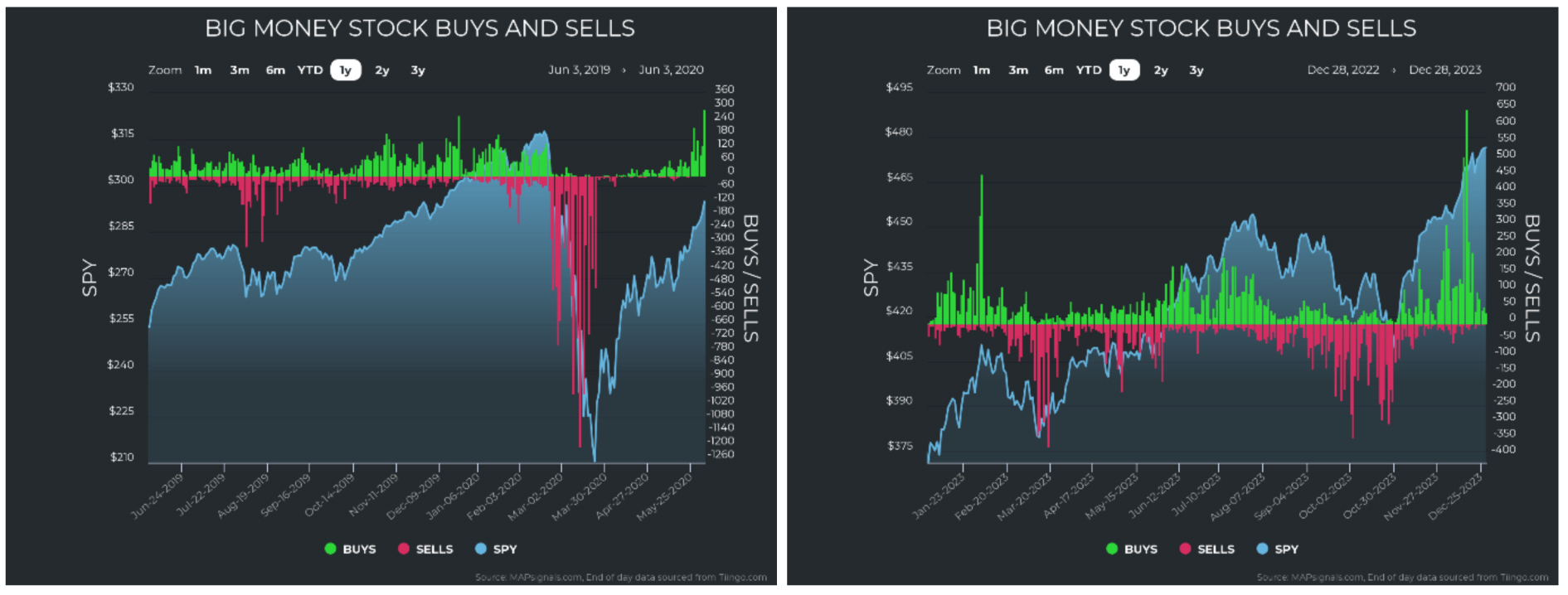
Graphs are for illustrative and discussion purposes only. Please read important disclosures at the end of this commentary.
Next up we see the same thing for ETFs… COVID (mid-2020) on the left, today (late 2023) right:
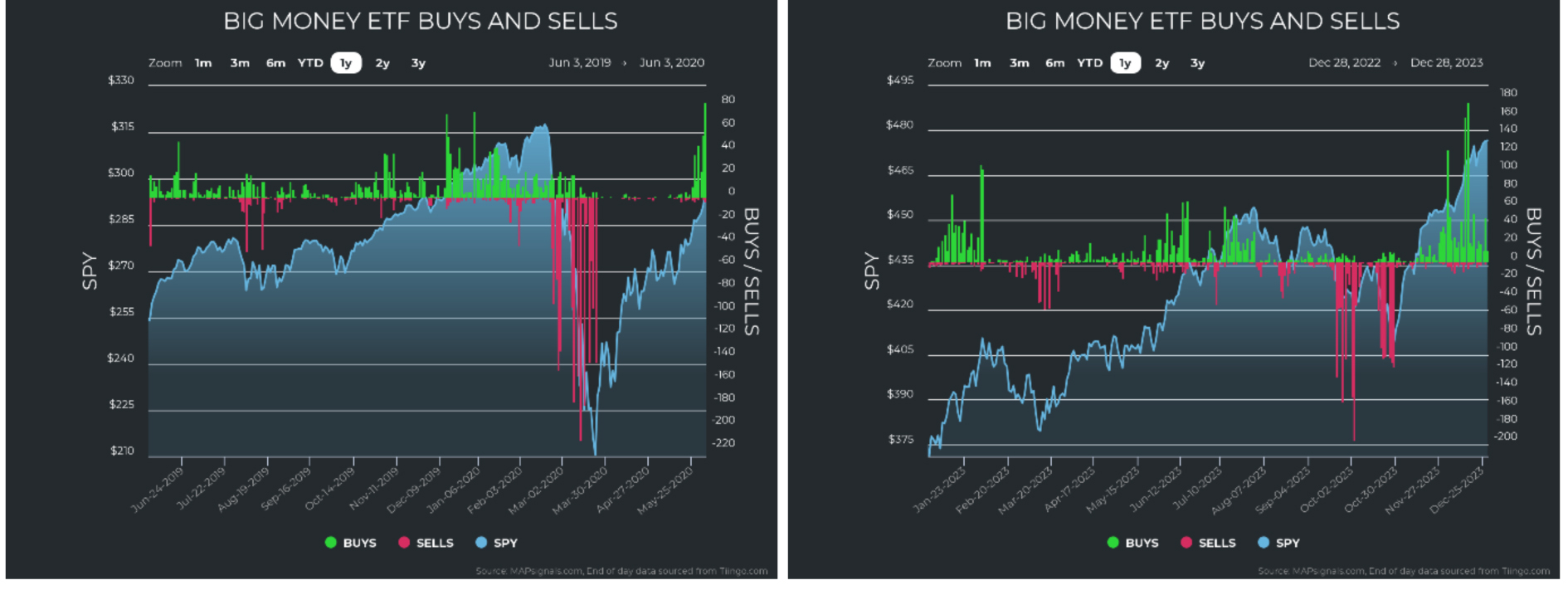
Graphs are for illustrative and discussion purposes only. Please read important disclosures at the end of this commentary.
The prior charts paint a picture of investors being on the wrong side and needing to correct their expectations quickly. You can blame it on short covering or value hunting or whatever you want, but the reality is that buying like this usually kicks off a big, sustained move.
Next, let’s look at which sectors led us out of the COVID crash and pushed stocks higher for the months and years afterwards. Then, we will compare that with today. For both periods, we see tech, discretionary, and industrials. Healthcare was strong during COVID for obvious reasons related to increased care.
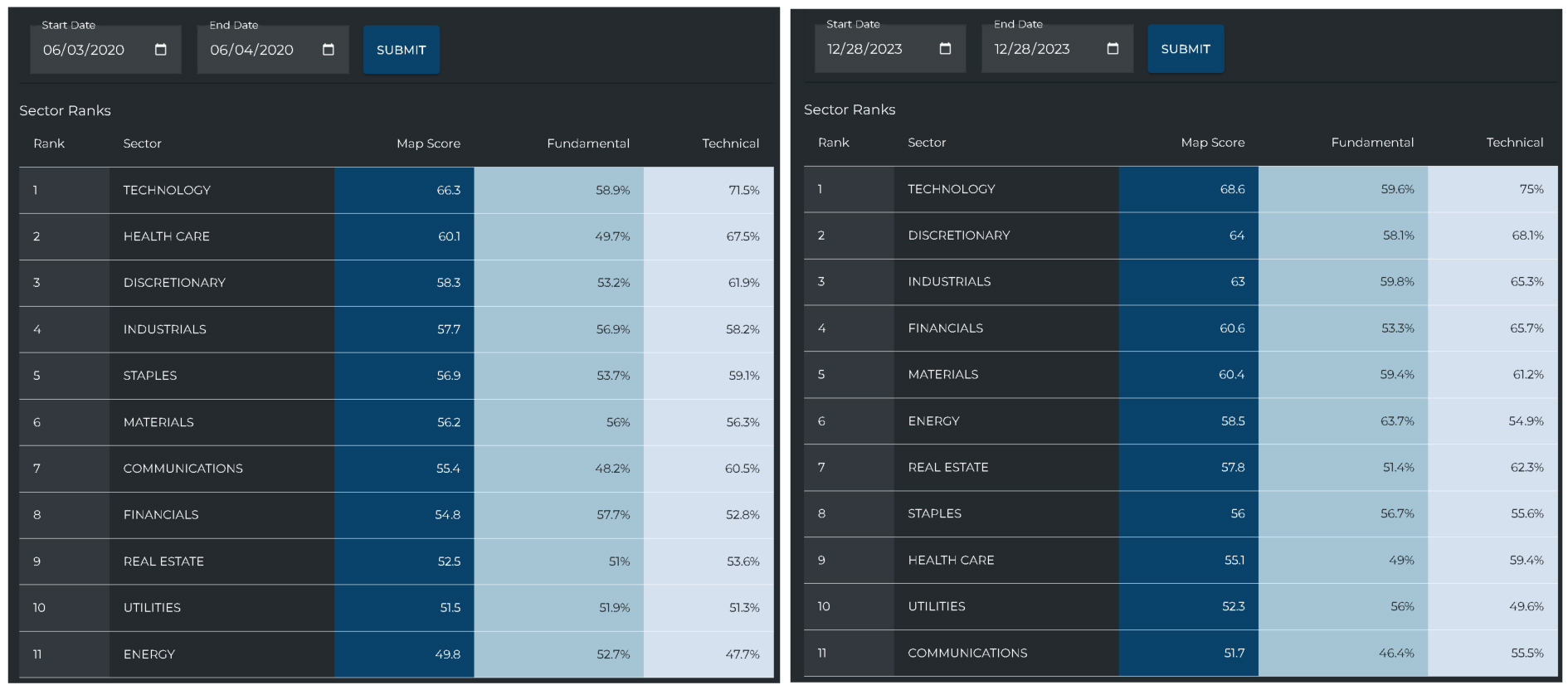
Graphs are for illustrative and discussion purposes only. Please read important disclosures at the end of this commentary.
In each case, growth led us higher. We can see that unusual buying is happening in nearly every sector. Tech, discretionary, industrials, financials, and materials have seen intense accumulation. Real estate, staples, healthcare, utilities and communications have also been under accumulation. Only energy has not been rallying, as it is taking a pause from a peak +250% run since November 2020.
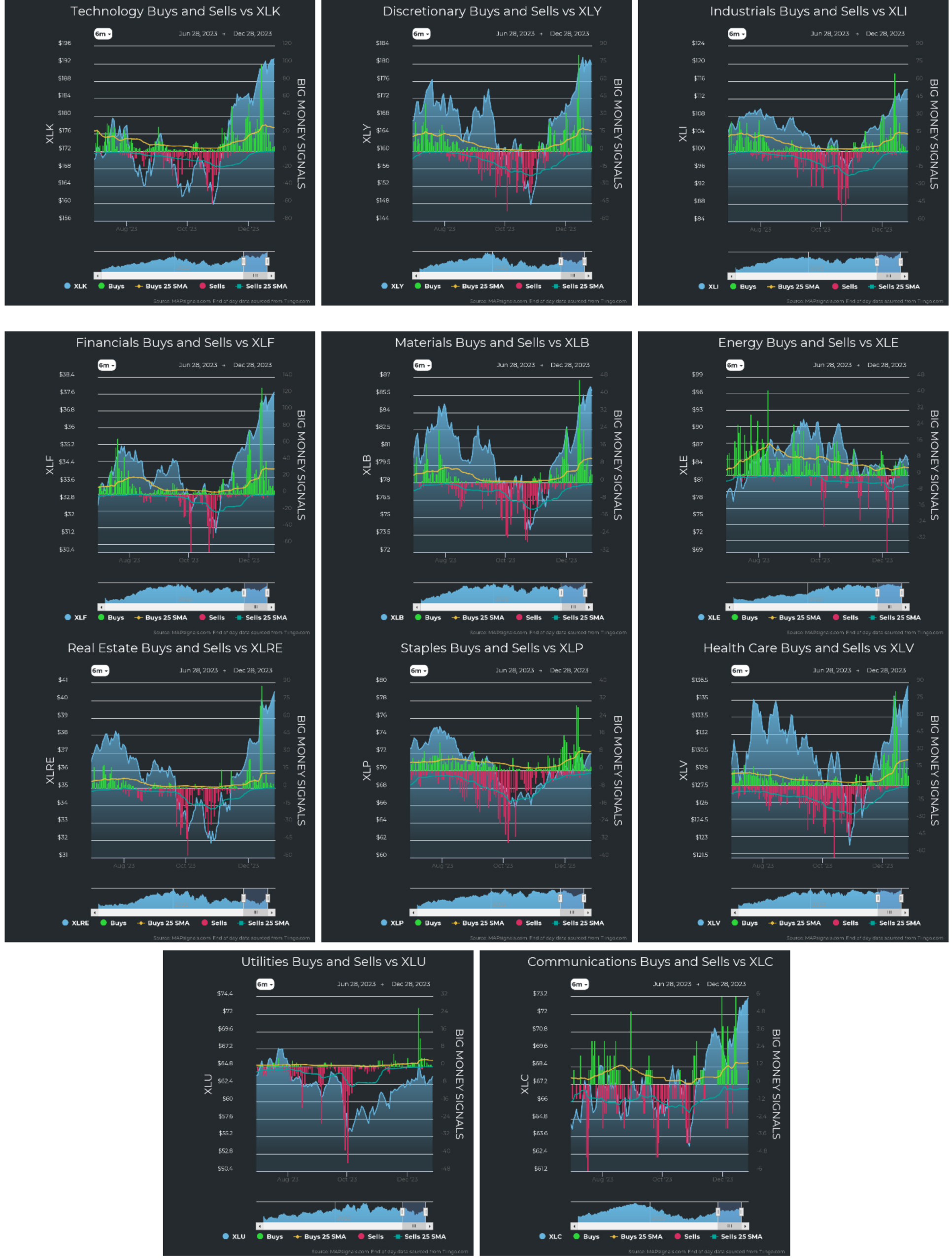
Graphs are for illustrative and discussion purposes only. Please read important disclosures at the end of this commentary.
The symmetry of the two periods bodes well historically. The rally out of COVID realized more than a doubling of the S&P 500. This time around we are only up +17% so far, but there is one key difference: interest rate trends. When COVID hit, central banks flooded the world with money and lent it zero interest. That had the desired effect of sparking the economy and carrying us through a troubled time.
The undesirable side-effect was inflation. Today, inflation is still here but it is falling. Interest rates rose this time to combat nasty inflation. And as of right now, there is a significant 2+% spread between inflation and interest rates as evidenced by this chart (data from BLS.gov and stlouisfed.org):
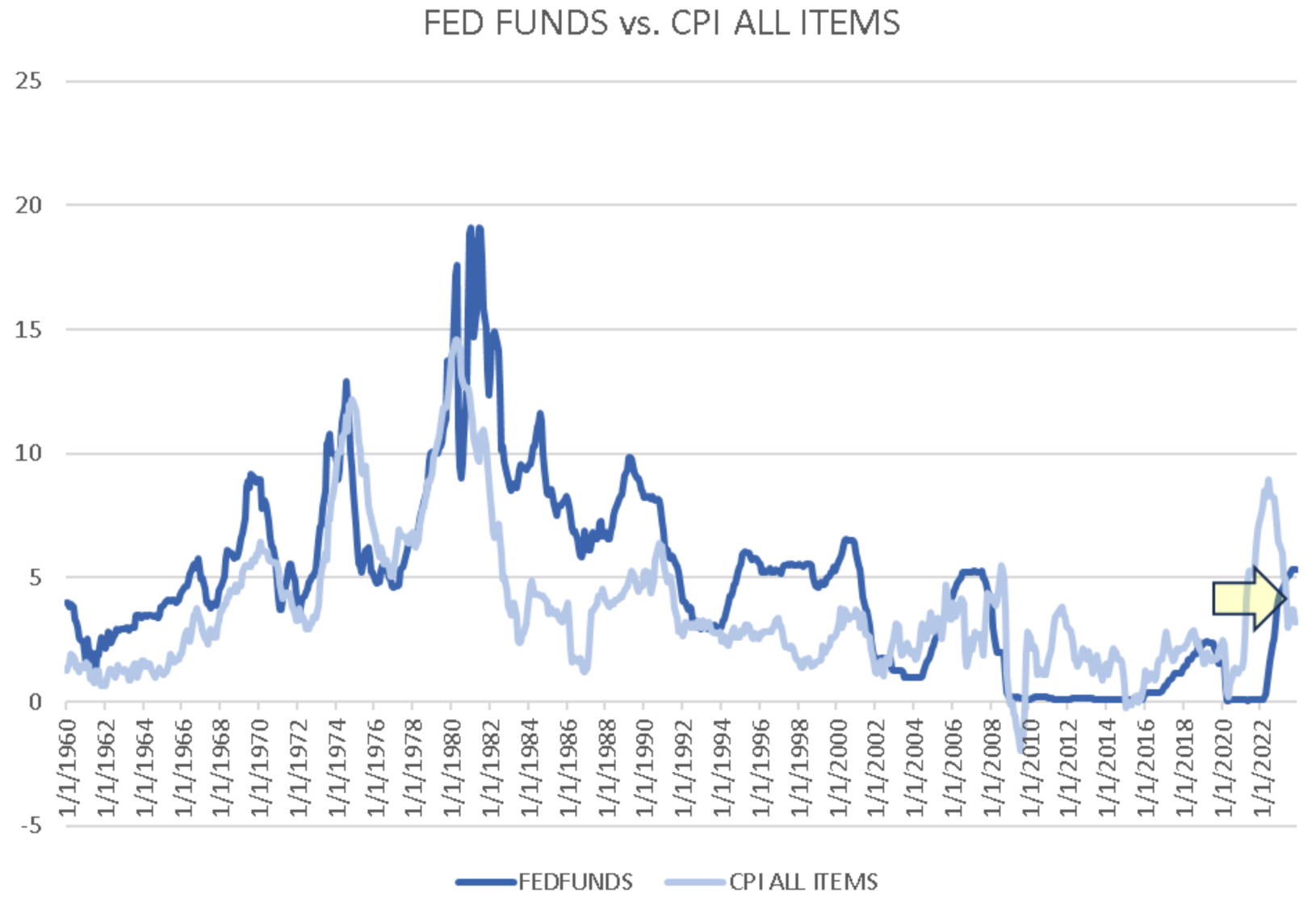
Graphs are for illustrative and discussion purposes only. Please read important disclosures at the end of this commentary.
Since 1960, interest rates have usually been below inflation. This indicates the inversion won’t last. The Fed has already telegraphed 6-7 cuts through 2025. I suspect rate cuts will begin as soon as this quarter.
In this long-term chart, we are well below average inflation. Jerome Powell has said, for a long time, that he remains committed to a long-term goal of 2% inflation. Well, the average CPI (a proxy for inflation) since 1960 is 3.77%, nearly double his “long-term goal.” In essence, 2% is a unicorn, historically low.
I should also point out that while the average fed funds rate since 1960 is 4.79% and much lower the past 23 years: since 2000 it’s 1.77%. Inflation since 2000 averages 2.56% – still above the long-term goal of 2%. In short, rates will fall. I believe we are on the cusp of a long bull run for stocks. It’s only just begun.
Bottom’s up to a new year, but heed this famous warning from a writer familiar with such toasts:
“First you take a drink, then the drink takes a drink, then the drink takes you.” – F. Scott Fitzgerald
All content above represents the opinion of Jason Bodner of Navellier & Associates, Inc.
Also In This Issue
A Look Ahead by Louis Navellier
Will Guyana Become Britain’s Next “Falklands War”?
Income Mail by Bryan Perry
Rising Debt is Weighing Down King Dollar’s Reign
Growth Mail by Gary Alexander
It’s Decision Time: Roaring ‘20s or Stagnant ‘70s?
Global Mail by Ivan Martchev
Emerging Markets are Overdue to Outperform
Sector Spotlight by Jason Bodner
Comparing Rapid Recoveries: Late 2023 vs. Mid-2020
View Full Archive
Read Past Issues Here

Jason Bodner
MARKETMAIL EDITOR FOR SECTOR SPOTLIGHT
Jason Bodner writes Sector Spotlight in the weekly Marketmail publication and has authored several white papers for the company. He is also Co-Founder of Macro Analytics for Professionals which produces proprietary equity accumulation/distribution research for its clients. Previously, Mr. Bodner served as Director of European Equity Derivatives for Cantor Fitzgerald Europe in London, then moved to the role of Head of Equity Derivatives North America for the same company in New York. He also served as S.V.P. Equity Derivatives for Jefferies, LLC. He received a B.S. in business administration in 1996, with honors, from Skidmore College as a member of the Periclean Honors Society. All content of “Sector Spotlight” represents the opinion of Jason Bodner
Important Disclosures:
Jason Bodner is a co-founder and co-owner of Mapsignals. Mr. Bodner is an independent contractor who is occasionally hired by Navellier & Associates to write an article and or provide opinions for possible use in articles that appear in Navellier & Associates weekly Market Mail. Mr. Bodner is not employed or affiliated with Louis Navellier, Navellier & Associates, Inc., or any other Navellier owned entity. The opinions and statements made here are those of Mr. Bodner and not necessarily those of any other persons or entities. This is not an endorsement, or solicitation or testimonial or investment advice regarding the BMI Index or any statements or recommendations or analysis in the article or the BMI Index or Mapsignals or its products or strategies.
Although information in these reports has been obtained from and is based upon sources that Navellier believes to be reliable, Navellier does not guarantee its accuracy and it may be incomplete or condensed. All opinions and estimates constitute Navellier’s judgment as of the date the report was created and are subject to change without notice. These reports are for informational purposes only and are not a solicitation for the purchase or sale of a security. Any decision to purchase securities mentioned in these reports must take into account existing public information on such securities or any registered prospectus.To the extent permitted by law, neither Navellier & Associates, Inc., nor any of its affiliates, agents, or service providers assumes any liability or responsibility nor owes any duty of care for any consequences of any person acting or refraining to act in reliance on the information contained in this communication or for any decision based on it.
Past performance is no indication of future results. Investment in securities involves significant risk and has the potential for partial or complete loss of funds invested. It should not be assumed that any securities recommendations made by Navellier. in the future will be profitable or equal the performance of securities made in this report. Dividend payments are not guaranteed. The amount of a dividend payment, if any, can vary over time and issuers may reduce dividends paid on securities in the event of a recession or adverse event affecting a specific industry or issuer.
None of the stock information, data, and company information presented herein constitutes a recommendation by Navellier or a solicitation to buy or sell any securities. Any specific securities identified and described do not represent all of the securities purchased, sold, or recommended for advisory clients. The holdings identified do not represent all of the securities purchased, sold, or recommended for advisory clients and the reader should not assume that investments in the securities identified and discussed were or will be profitable.
Information presented is general information that does not take into account your individual circumstances, financial situation, or needs, nor does it present a personalized recommendation to you. Individual stocks presented may not be suitable for every investor. Investment in securities involves significant risk and has the potential for partial or complete loss of funds invested. Investment in fixed income securities has the potential for the investment return and principal value of an investment to fluctuate so that an investor’s holdings, when redeemed, may be worth less than their original cost.
One cannot invest directly in an index. Index is unmanaged and index performance does not reflect deduction of fees, expenses, or taxes. Presentation of Index data does not reflect a belief by Navellier that any stock index constitutes an investment alternative to any Navellier equity strategy or is necessarily comparable to such strategies. Among the most important differences between the Indices and Navellier strategies are that the Navellier equity strategies may (1) incur material management fees, (2) concentrate its investments in relatively few stocks, industries, or sectors, (3) have significantly greater trading activity and related costs, and (4) be significantly more or less volatile than the Indices.
ETF Risk: We may invest in exchange traded funds (“ETFs”) and some of our investment strategies are generally fully invested in ETFs. Like traditional mutual funds, ETFs charge asset-based fees, but they generally do not charge initial sales charges or redemption fees and investors typically pay only customary brokerage fees to buy and sell ETF shares. The fees and costs charged by ETFs held in client accounts will not be deducted from the compensation the client pays Navellier. ETF prices can fluctuate up or down, and a client account could lose money investing in an ETF if the prices of the securities owned by the ETF go down. ETFs are subject to additional risks:
- ETF shares may trade above or below their net asset value;
- An active trading market for an ETF’s shares may not develop or be maintained;
- The value of an ETF may be more volatile than the underlying portfolio of securities the ETF is designed to track;
- The cost of owning shares of the ETF may exceed those a client would incur by directly investing in the underlying securities; and
- Trading of an ETF’s shares may be halted if the listing exchange’s officials deem it appropriate, the shares are delisted from the exchange, or the activation of market-wide “circuit breakers” (which are tied to large decreases in stock prices) halts stock trading generally.
Grader Disclosures: Investment in equity strategies involves substantial risk and has the potential for partial or complete loss of funds invested. The sample portfolio and any accompanying charts are for informational purposes only and are not to be construed as a solicitation to buy or sell any financial instrument and should not be relied upon as the sole factor in an investment making decision. As a matter of normal and important disclosures to you, as a potential investor, please consider the following: The performance presented is not based on any actual securities trading, portfolio, or accounts, and the reported performance of the A, B, C, D, and F portfolios (collectively the “model portfolios”) should be considered mere “paper” or pro forma performance results based on Navellier’s research.
Investors evaluating any of Navellier & Associates, Inc.’s, (or its affiliates’) Investment Products must not use any information presented here, including the performance figures of the model portfolios, in their evaluation of any Navellier Investment Products. Navellier Investment Products include the firm’s mutual funds and managed accounts. The model portfolios, charts, and other information presented do not represent actual funded trades and are not actual funded portfolios. There are material differences between Navellier Investment Products’ portfolios and the model portfolios, research, and performance figures presented here. The model portfolios and the research results (1) may contain stocks or ETFs that are illiquid and difficult to trade; (2) may contain stock or ETF holdings materially different from actual funded Navellier Investment Product portfolios; (3) include the reinvestment of all dividends and other earnings, estimated trading costs, commissions, or management fees; and, (4) may not reflect prices obtained in an actual funded Navellier Investment Product portfolio. For these and other reasons, the reported performances of model portfolios do not reflect the performance results of Navellier’s actually funded and traded Investment Products. In most cases, Navellier’s Investment Products have materially lower performance results than the performances of the model portfolios presented.
This report contains statements that are, or may be considered to be, forward-looking statements. All statements that are not historical facts, including statements about our beliefs or expectations, are “forward-looking statements” within the meaning of The U.S. Private Securities Litigation Reform Act of 1995. These statements may be identified by such forward-looking terminology as “expect,” “estimate,” “plan,” “intend,” “believe,” “anticipate,” “may,” “will,” “should,” “could,” “continue,” “project,” or similar statements or variations of such terms. Our forward-looking statements are based on a series of expectations, assumptions, and projections, are not guarantees of future results or performance, and involve substantial risks and uncertainty as described in Form ADV Part 2A of our filing with the Securities and Exchange Commission (SEC), which is available at www.adviserinfo.sec.gov or by requesting a copy by emailing info@navellier.com. All of our forward-looking statements are as of the date of this report only. We can give no assurance that such expectations or forward-looking statements will prove to be correct. Actual results may differ materially. You are urged to carefully consider all such factors.
FEDERAL TAX ADVICE DISCLAIMER: As required by U.S. Treasury Regulations, you are informed that, to the extent this presentation includes any federal tax advice, the presentation is not written by Navellier to be used, and cannot be used, for the purpose of avoiding federal tax penalties. Navellier does not advise on any income tax requirements or issues. Use of any information presented by Navellier is for general information only and does not represent tax advice either express or implied. You are encouraged to seek professional tax advice for income tax questions and assistance.
IMPORTANT NEWSLETTER DISCLOSURE:The hypothetical performance results for investment newsletters that are authored or edited by Louis Navellier, including Louis Navellier’s Growth Investor, Louis Navellier’s Breakthrough Stocks, Louis Navellier’s Accelerated Profits, and Louis Navellier’s Platinum Club, are not based on any actual securities trading, portfolio, or accounts, and the newsletters’ reported hypothetical performances should be considered mere “paper” or proforma hypothetical performance results and are not actual performance of real world trades. Navellier & Associates, Inc. does not have any relation to or affiliation with the owner of these newsletters. There are material differences between Navellier Investment Products’ portfolios and the InvestorPlace Media, LLC newsletter portfolios authored by Louis Navellier. The InvestorPlace Media, LLC newsletters contain hypothetical performance that do not include transaction costs, advisory fees, or other fees a client might incur if actual investments and trades were being made by an investor. As a result, newsletter performance should not be used to evaluate Navellier Investment services which are separate and different from the newsletters. The owner of the newsletters is InvestorPlace Media, LLC and any questions concerning the newsletters, including any newsletter advertising or hypothetical Newsletter performance claims, (which are calculated solely by Investor Place Media and not Navellier) should be referred to InvestorPlace Media, LLC at (800) 718-8289.
Please note that Navellier & Associates and the Navellier Private Client Group are managed completely independent of the newsletters owned and published by InvestorPlace Media, LLC and written and edited by Louis Navellier, and investment performance of the newsletters should in no way be considered indicative of potential future investment performance for any Navellier & Associates separately managed account portfolio. Potential investors should consult with their financial advisor before investing in any Navellier Investment Product.
Navellier claims compliance with Global Investment Performance Standards (GIPS). To receive a complete list and descriptions of Navellier’s composites and/or a presentation that adheres to the GIPS standards, please contact Navellier or click here. It should not be assumed that any securities recommendations made by Navellier & Associates, Inc. in the future will be profitable or equal the performance of securities made in this report.
FactSet Disclosure: Navellier does not independently calculate the statistical information included in the attached report. The calculation and the information are provided by FactSet, a company not related to Navellier. Although information contained in the report has been obtained from FactSet and is based on sources Navellier believes to be reliable, Navellier does not guarantee its accuracy, and it may be incomplete or condensed. The report and the related FactSet sourced information are provided on an “as is” basis. The user assumes the entire risk of any use made of this information. Investors should consider the report as only a single factor in making their investment decision. The report is for informational purposes only and is not intended as an offer or solicitation for the purchase or sale of a security. FactSet sourced information is the exclusive property of FactSet. Without prior written permission of FactSet, this information may not be reproduced, disseminated or used to create any financial products. All indices are unmanaged and performance of the indices include reinvestment of dividends and interest income, unless otherwise noted, are not illustrative of any particular investment and an investment cannot be made in any index. Past performance is no guarantee of future results.
